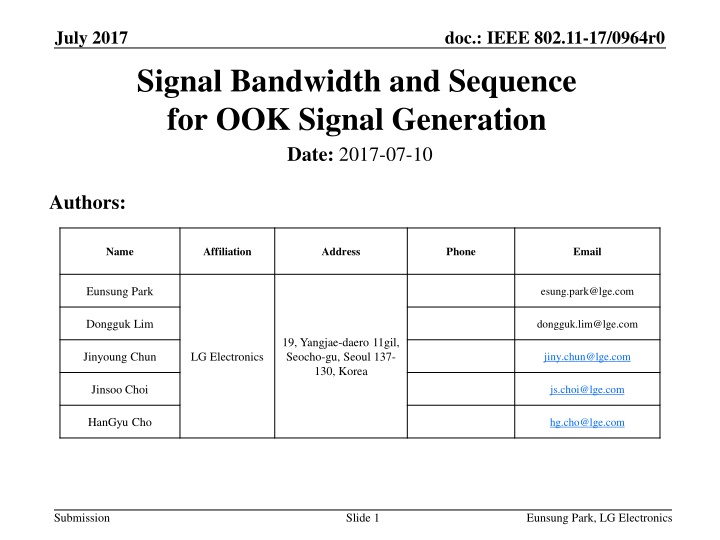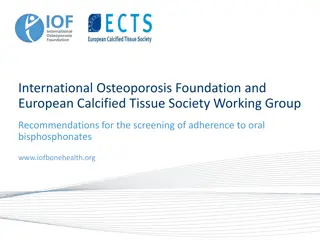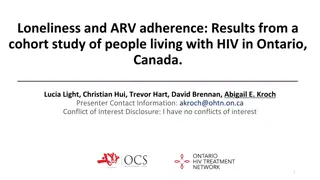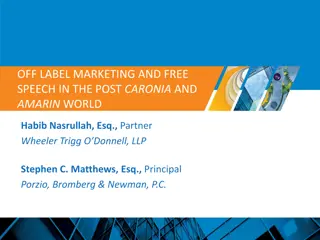Impact of EU Label Changes on Risk Awareness and Adherence
Study conducted by Anastasia Lili in January 2021 to assess awareness and adherence to Pregnancy Prevention Programme for medicinal products containing valproate-related substances and oral retinoids. The research objectives, methods, results, and conclusions are outlined, along with details on study samples and recruitment strategies.
Download Presentation

Please find below an Image/Link to download the presentation.
The content on the website is provided AS IS for your information and personal use only. It may not be sold, licensed, or shared on other websites without obtaining consent from the author.If you encounter any issues during the download, it is possible that the publisher has removed the file from their server.
You are allowed to download the files provided on this website for personal or commercial use, subject to the condition that they are used lawfully. All files are the property of their respective owners.
The content on the website is provided AS IS for your information and personal use only. It may not be sold, licensed, or shared on other websites without obtaining consent from the author.
E N D
Presentation Transcript
July 2017 doc.: IEEE 802.11-17/0964r0 Signal Bandwidth and Sequence for OOK Signal Generation Date: 2017-07-10 Authors: Name Affiliation Address Phone Email Eunsung Park esung.park@lge.com Dongguk Lim dongguk.lim@lge.com 19, Yangjae-daero 11gil, Seocho-gu, Seoul 137- 130, Korea Jinyoung Chun LG Electronics jiny.chun@lge.com Jinsoo Choi js.choi@lge.com HanGyu Cho hg.cho@lge.com Submission Slide 1 Eunsung Park, LG Electronics
July 2017 doc.: IEEE 802.11-17/0964r0 Introduction We already agreed that the OOK waveform of wake-up packet is generated by populating some subcarriers Also, the signal bandwidth of 4MHz was recommended to generate the OOK signal in [1] i.e., 13 subcarriers with the subcarrier spacing of 312.5KHz In this contribution, by focusing on the 4MHz bandwidth, we introduce several sequences which are applied to 13 subcarriers Some of them were proposed in [2][3][4] We additionally propose a sequence which optimizes PAPR and compare it with the above sequences Submission Slide 2 Eunsung Park, LG Electronics
July 2017 doc.: IEEE 802.11-17/0964r0 Signal Bandwidth In the last f2f meeting in May, there was a lot of discussion on the OOK waveform generation Some members were concerned about having too many optional features in 11ba While other members did not want to exclude any possibilities such as multi-band transmission, concurrent transmission with 11ax frames using 11ax tone plan, etc. In this contribution, we only focus on the following cases to propose signal bandwidth and sequence for OOK signal generation The conventional Wi-Fi transmitter is used, i.e., the subcarrier spacing is 312.5KHz Single band is used for wake-up packet transmission In this case, we suggest using 4MHz signal bandwidth (i.e., 13 subcarriers) as a mandatory feature Slide 3 Submission Eunsung Park, LG Electronics
July 2017 doc.: IEEE 802.11-17/0964r0 Sequences As to the sequence, we propose that the length is 13 and the coefficient at the center tone is zero to prevent the DC offset Option 1 : Optimized sequence in terms of the PAPR [1,1,1,-1,-1,-1,0,-1,1,-1,-1,1,-1] Option 2 : Reuse the conventional L-STF sequence by choosing coefficients at tones of all multiples of 4 from -24 to 24 [2] [1,-1,1,-1,-1,1,0,-1,-1,1,1,1,1] * (1+j)/sqrt(2) Option 3 : Reuse the conventional L-LTF sequence by choosing coefficients at tones from -6 to 6 [3] [1,-1,1,1,1,1,0,1,-1,-1,1,1,-1] Option 4 : Optimized sequence in terms of the average power between CP and signal portions (similar average power between them) [4] [-1,-1,-1,1,1,-1,0,-1,-1,-1,1,-1,1] Submission Slide 4 Eunsung Park, LG Electronics
July 2017 doc.: IEEE 802.11-17/0964r0 Comparison PAPR and average CP power to average signal power ratio (ACASR) are examined PAPR is calculated by applying 4 times IFFT CP portion is not considered ACASR is calculated by comparing a CP portion of 0.8us (16 samples) and a signal part of 3.2us (64 samples) Note that the ACASR was utilized in [4] to obtain the sequence which minimizes it 3.2us signal (64 samples) 0.8us CP (16 samples) Option 1 Option 2 Option 3 Option 4 PAPR [dB] 2.0589 2.2394 4.1516 4.0073 ACASR [dB] -0.0455 0.0450 -0.5964 -0.0423 In back-up slides, PAPR and average power for 0.5/1/2us ON-signals which are selected from the 3.2us or 4us signal in each option are shown Submission Slide 5 Eunsung Park, LG Electronics
July 2017 doc.: IEEE 802.11-17/0964r0 Discussion In terms of the PAPR, option 1 is the best and option 2 is comparable Trend is similar even when we calculate the PAPR considering the CP part as shown in back-up slides Note that option 1 has a better PAPR than that of the conventional Wi-Fi Given the PAPR of the data part for the conventional Wi-Fi as shown in Appendix A, Option 3 and 4 may be also acceptable In terms of the ACASR, option 4 is the best and option 1 and 2 are comparable If the average CP power is not similar to that of the signal part (i.e., the average CP power is significantly low or high compared to that of the signal part), it may cause performance degradation due to SNR decrease, ISI impact, etc. However, the performance gap among these four options is not huge as shown in Appendix B Submission Slide 6 Eunsung Park, LG Electronics
July 2017 doc.: IEEE 802.11-17/0964r0 Conclusion We suggested using 4MHz signal bandwidth (i.e., 13 subcarriers) as a mandatory feature when the subcarrier spacing is 312.5KHz and a single band is used for wake-up packet transmission We also dealt with four sequences with the length of 13 for the OOK signal generation In each sequence, the PAPR and the ACASR were investigated From the PAPR viewpoint, it may be advisable to use option 1 or 2 From the ACASR viewpoint, it may be advisable to use option 1, 2 or 4 Slide 7 Submission Eunsung Park, LG Electronics
July 2017 doc.: IEEE 802.11-17/0964r0 Straw Poll #1 Do you agree to add the following to the 11ba SFD? When the subcarrier spacing is 312.5KHz and a single band is used for transmission of wake-up packet, the OOK waveform of wake- up packet is generated by using contiguous 13 subcarriers The center subcarrier should be null Y/N/A : Submission Slide 8 Eunsung Park, LG Electronics
July 2017 doc.: IEEE 802.11-17/0964r0 Straw Poll #2 Which option do you prefer for the sequence that is applied to 13 subcarriers to generate 4us OOK ON-signal when the subcarrier spacing is 312.5KHz and a single band is used for transmission of wake-up packet? Option 1 : Optimized sequence in terms of the PAPR [1,1,1,-1,-1,-1,0,-1,1,-1,-1,1,-1] Option 2 : Reuse the conventional L-STF sequence by choosing coefficients at tones of all multiples of 4 from -24 to 24 [1,-1,1,-1,-1,1,0,-1,-1,1,1,1,1] * (1+j)/sqrt(2) Option 3 : Reuse the conventional L-LTF sequence by choosing coefficients at tones from -6 to 6 [1,-1,1,1,1,1,0,1,-1,-1,1,1,-1] Option 4 : Optimized sequence in terms of the average power between CP and signal portions [-1,-1,-1,1,1,-1,0,-1,-1,-1,1,-1,1] Op1/Op2/Op3/Op4/A : Submission Slide 9 Eunsung Park, LG Electronics
July 2017 doc.: IEEE 802.11-17/0964r0 Straw Poll #3 Do you agree to add the following to the 11ba SFD? When the subcarrier spacing is 312.5KHz and a single band is used for transmission of wake-up packet, a same sequence is used to generate OOK ON-signals for all of the data rates Y/N/A : Submission Slide 10 Eunsung Park, LG Electronics
July 2017 doc.: IEEE 802.11-17/0964r0 References [1] IEEE 802.11-17/0655r4 OOK Signal Bandwidth for WUR [2] IEEE 802.11-17/0656r0 WUR PHY Performance Study with Phase Noise and ACI [4] IEEE 802.11-17/373r1 Performance Investigations on Single-carrier and Multiple-carrier-based WUR [4] IEEE 802.11-17/0676r1 WUR Link Budget Analysis Follow-up : Data Rates and SIG Bits Protection Submission Slide 11 Eunsung Park, LG Electronics
July 2017 doc.: IEEE 802.11-17/0964r0 Appendix Submission Slide 12 Eunsung Park, LG Electronics
July 2017 doc.: IEEE 802.11-17/0964r0 Appendix A PAPR of the data part for 802.11ac in 20MHz PAPR of Data Part for 802.11ac in 20MHz 1 BPSK QAM 0.9 0.8 0.7 0.6 CDF 0.5 0.4 0.3 0.2 0.1 0 2 4 6 8 10 12 14 PAPR [dB] Submission Slide 13 Eunsung Park, LG Electronics
July 2017 doc.: IEEE 802.11-17/0964r0 Appendix B 125Kbps data rate with Manchester coding PER for the payload of 48 bits CFO and phase noise applied PER Performance in UMi NLoS Channel PER Performance in TGnD Channel 0 0 10 10 Option 1 Option 2 Option 3 Option 4 Option 1 Option 2 Option 3 Option 4 -1 -1 10 10 PER PER -2 -2 10 10 -3 -3 10 10 -6 -4 -2 0 2 4 6 8 10 12 14 -6 -4 -2 0 2 4 6 8 10 12 14 SNR [dB] SNR [dB] TGnD Channel UMi NLoS Channel Submission Slide 14 Eunsung Park, LG Electronics
July 2017 doc.: IEEE 802.11-17/0964r0 Back Up Submission Slide 15 Eunsung Park, LG Electronics
July 2017 doc.: IEEE 802.11-17/0964r0 PAPR and Average Power 4us ON signal Sample idx Option 1 1/0.9896 (2.0611) Option 2 1/1.0104 (2.2371) Option 3 1/0.8717 (4.2759) Option 4 1/0.9903 (3.9954) 1~64 + CP average normalized signal power / average CP power (PAPR [dB]) Submission Slide 16 Eunsung Park, LG Electronics
July 2017 doc.: IEEE 802.11-17/0964r0 PAPR and Average Power 2us ON signal select first or second 32 samples in 64 samples and insert 8 CP Sample idx Option 1 Option 2 1/1.1249 (2.0003) (2.2804) 1/1.1249 (2.0003) (2.2804) Option 3 1.0208/0.9599 (4.2364) 0.9792/0.9208 (4.2142) Option 4 1/0.9853 (3.9930) 1/1.0021 (4.0538) 1/0.9585 1~32 + CP 1/0.9585 33~64 + CP average normalized signal power / average CP power (PAPR [dB]) Submission Slide 17 Eunsung Park, LG Electronics
July 2017 doc.: IEEE 802.11-17/0964r0 PAPR and Average Power 1us ON signal select 16 samples and insert 4 CP Sample idx Option 1 1.0104/0.6224 (2.4872) 0.9896/1.0616 (2.0884) 1.0104/0.6224 (2.4872) 0.9896/1.0616 (2.0884) Option 2 0.9896/1.2087 (2.1466) 1.0104/0.7695 (2.5338) 0.9896/1.2087 (2.1466) 1.0104/0.7695 (2.5338) Option 3 0.8508/0.5245 (2.4873) 1.1908/0.8107 (3.8541) 1.0867/1.8506 (3.0136) 0.8717/1.1911 (2.5171) Option 4 1.0528/0.5378 (4.3540) 0.9472/1.6514 (2.4228) 1.0097/0.8239 (3.1590) 0.9903/0.6927 (4.1239) 1~16 + CP 17~32 + CP 33~48 + CP 49~64 + CP average normalized signal power / average CP power (PAPR [dB]) Submission Slide 18 Eunsung Park, LG Electronics
July 2017 doc.: IEEE 802.11-17/0964r0 PAPR and Average Power 0.5us ON signal select 8 samples and insert 2 CP Sample idx Option 1 Option 2 Option 3 Option 4 0.9790/1.1004 (1.3079) 0.9376/1.2076 (2.4105) 1.0005/0.5909 (1.7353) 0.8634/1.3160 (3.4441) 1~8 + CP 1.0418/0.3149 (2.9152) 1.0415/0.9058 (2.0841) 0.7011/0.5081 (2.8402) 1.2422/0.4491 (4.0059) 9~16 + CP 0.8543/1.5432 (1.8291) 1.0624/0.7648 (2.2233) 1.4217/1.0102 (2.7253) 0.9091/1.1600 (1.4824) 17~24 + CP 1.1249/0.8059 (1.8259) 0.9585/0.4148 (3.0083) 0.9599/0.5754 (3.1953) 0.9853/1.7010 (2.3394) 25~32 + CP 0.9790/1.1004 (1.3079) 0.9376/1.2076 (2.4105) 0.7551/1.0588 (2.4608) 1.0823/0.0836 (3.5187) 33~40 + CP 1.0418/0.3149 (2.9152) 1.0415/0.9058 (2.0841) 1.4182/2.4842 (2.0556) 0.9371/0.5553 (1.9997) 41~48 + CP 0.8543/1.5432 (1.8291) 1.0624/0.7648 (2.2233) 0.8226/0.9240 (3.2464) 0.9785/2.1116 (2.8054) 49~56 + CP 1.1249/0.8059 (1.8259) average normalized signal power / average CP power (PAPR [dB]) 0.9585/0.4148 (3.0083) 0.9208/1.3197 (1.1498) 1.0021/1.0948 (3.9048) 57~64 + CP Submission Slide 19 Eunsung Park, LG Electronics
July 2017 doc.: IEEE 802.11-17/0964r0 PAPR and Average Power 2us ON signal select first or second 40 samples in 80 samples (16 CP + 64 samples) Range first 2us last 2us Option 1 2.1228 2.0003 Option 2 2.1942 2.2804 Option 3 4.2783 4.2734 Option 4 3.9978 3.9930 PAPR [dB] Submission Slide 20 Eunsung Park, LG Electronics
July 2017 doc.: IEEE 802.11-17/0964r0 PAPR and Average Power 1us ON signal select 20 samples Range first 1us second 1us third 1us last 1us Option 1 2.1307 2.1051 1.5464 2.5072 Option 2 2.5952 1.8271 2.4375 2.1289 Option 3 2.4949 4.1335 2.7863 3.8081 Option 4 4.0556 3.9408 2.6718 4.1905 PAPR [dB] Submission Slide 21 Eunsung Park, LG Electronics
July 2017 doc.: IEEE 802.11-17/0964r0 PAPR and Average Power 0.5us ON signal select 10 samples Range first 0.5us second 0.5us third 0.5us forth 0.5us fifth 0.5us sixth 0.5us seventh 0.5us last 0.5us Option 1 2.0925 1.4864 1.2842 3.1182 1.9052 0.9761 3.5048 1.3877 Option 2 2.0040 3.0897 1.4725 2.0661 3.0277 1.9179 1.4446 2.7417 Option 3 3.5382 0.6931 1.4750 3.0394 3.3159 2.3144 3.2492 1.5553 Option 4 3.0997 2.5252 3.1864 2.0944 2.3913 2.9717 3.6372 3.1733 PAPR [dB] Submission Slide 22 Eunsung Park, LG Electronics
July 2017 doc.: IEEE 802.11-17/0964r0 PAPR and Average Power 2us ON signal select 40 samples minimizing PAPR in 80 samples (16 CP + 64 samples) Option 1 20:59 (1.7991) Option 2 5:44 (2.1154) Option 3 26:65 (3.8325) Option 4 27:66 (3.2642) sample index (PAPR [dB]) Submission Slide 23 Eunsung Park, LG Electronics
July 2017 doc.: IEEE 802.11-17/0964r0 PAPR and Average Power 1us ON signal select 20 samples Option 1 7:26 (1.4413) Option 2 20:39/52:71 (1.7142) Option 3 5:24 (1.5005) Option 4 44:63 (2.2851) sample index (PAPR [dB]) Submission Slide 24 Eunsung Park, LG Electronics
July 2017 doc.: IEEE 802.11-17/0964r0 PAPR and Average Power 0.5us ON signal select 10 samples Option 1 5:14 (0.9759) Option 2 28:37 (1.3515) Option 3 12:21 (0.6061) Option 4 44:53 (1.0537) sample index (PAPR [dB]) Submission Slide 25 Eunsung Park, LG Electronics























